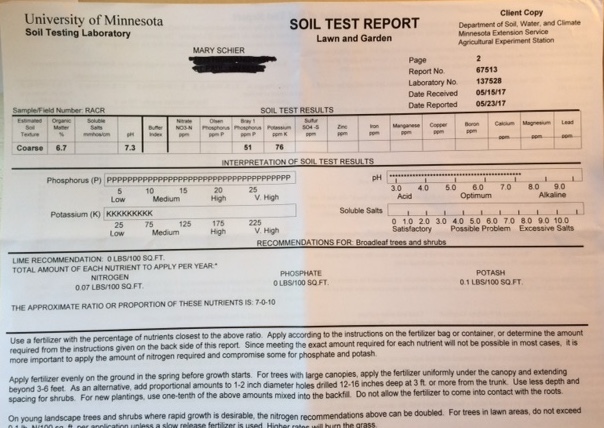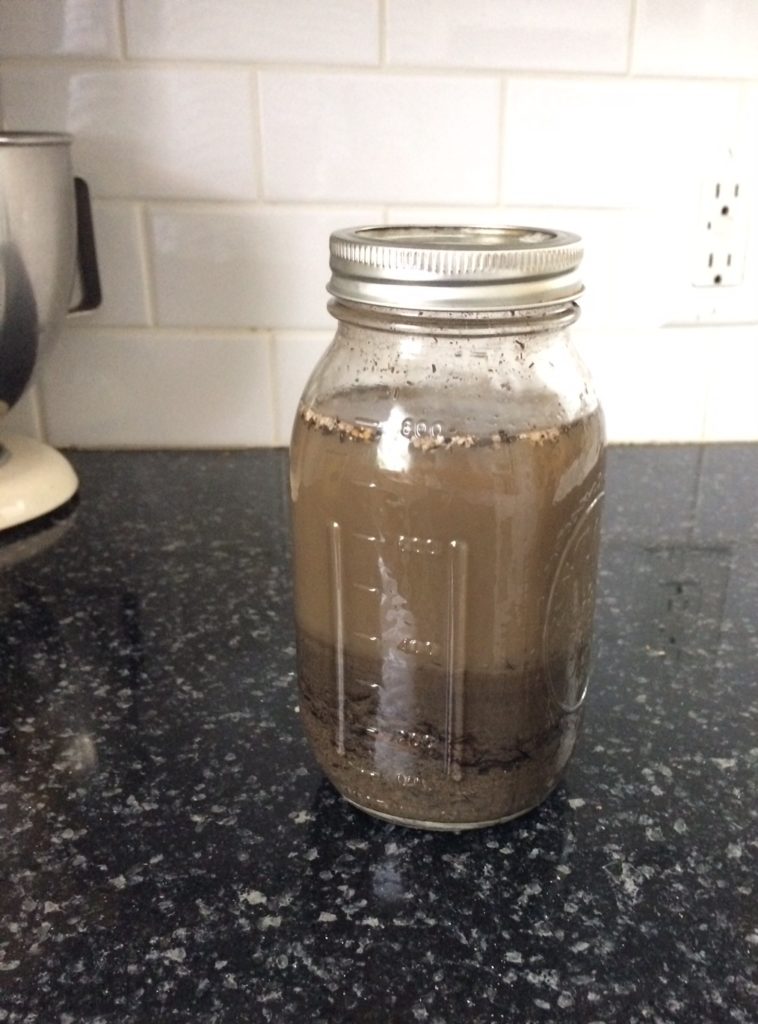Since I’m gardening in a new yard, I sent a couple of soil samples to the U of M Soil Testing Lab earlier this summer. Most horticulturists recommend a soil test as the first step in planning a garden because it helps you decide what additions, if any, you need to make to the soil.
For years, I did not have soil tests, but instead relied on the mantra: When in doubt, add compost. But I was concerned about the soil in my new garden, so I got the tests done.
A Solid C
The results came back within two weeks and, if my soil were getting a grade, it would be a solid C, maybe a C-. While not completely surprising, the tests show I have a lot of work to do to build organic matter and soil fertility. I had two different samples tested because I have two distinctly different garden areas in the backyard: one that had been planted with turf and hostas previously and one that had been the site of an old garage. We scraped off some of the garage-area soil and added 2 inches of black dirt, but clearly that was not enough.
 The better of my two soil test results is pictured above. This is for the turf/perennial area. It shows a coarse texture—more sandy than clay. The soil has a pH of 7.3, which is not terrible for Minnesota, and an organic matter percentage of 6.7 percent. My previous garden had a similar pH, but organic matter of over 10 percent. To be considered “organic” soil, a garden should have 19 percent or better organic matter. These garden beds will be getting a layer of leaves and compost over the winter and next spring to improve the soil fertility.
The better of my two soil test results is pictured above. This is for the turf/perennial area. It shows a coarse texture—more sandy than clay. The soil has a pH of 7.3, which is not terrible for Minnesota, and an organic matter percentage of 6.7 percent. My previous garden had a similar pH, but organic matter of over 10 percent. To be considered “organic” soil, a garden should have 19 percent or better organic matter. These garden beds will be getting a layer of leaves and compost over the winter and next spring to improve the soil fertility.
As with my previous garden, the phosphorus levels are sky-high. This garden has 51 parts per million of phosphorus, compared to a “very high” level of 25 ppm. My previous garden, however, had over 100 ppm of phosphorus. The potassium level is 76 ppm, a medium score, compared to more than 300 ppm on some soil I was sold for raised beds—which I think is too much.
The two key pieces of information from a soil test are the organic matter percentage and the fertilizer recommendations. The U suggested that any fertilizer I add to these beds have a ratio of 7-0-10—so no phosphorus, but some nitrogen and some potash.
Sandy, Clay or What?
The soil on the site of the former garage was also labeled as coarse by the U, which shocked me considering how difficult it has been to dig in. If the soil is wet, it actually makes a sucking sound when you pull a shovel of dirt out of it. It does have a lot of rocks, so I decided to do the low-tech test to find out if your soil is clay or sand.
The Jar Test
This is the test where you put a bunch of soil in a container, shake it up with water and let it settle. Because of the relative weight of the different types of soil (sand, silt and clay), the soil will settle out in layers, with the heaviest layer (sand) on the bottom and the lightest layer (clay) on top. For a better explanation of how this works and how to use a soil chart, check out this fine video.
It took forever for all the sand and silt and clay to settle out of my jar. The photo above was taken 48 hours after I started the test. Most of the videos/pictures I’ve seen show clear water on top and clear layers. My jar has some layers, but there is still a lot of soil floating around in the water. The soil did not fully settle out until about a week later. My best guess on composition is it is 50 percent sand, 20 percent silt and 20 percent clay. According to the soil chart (below), this kind of soil is considered loam or clay loam, which should be decent garden soil.
 Perhaps the problem isn’t the rocky (inorganic) part of the soil, but its complete lack of organic matter. According to the U, the organic matter level was an abysmal 2.7 percent. This is the reason I’m growing vegetables in raised beds.
Perhaps the problem isn’t the rocky (inorganic) part of the soil, but its complete lack of organic matter. According to the U, the organic matter level was an abysmal 2.7 percent. This is the reason I’m growing vegetables in raised beds.
But here’s the funny thing about this potentially atrocious soil–stuff is growing in it! I planted some cosmos and they seem to love it. I put in five plants of ‘Blue Heaven’ little bluestem and they’re happy as can be, as is a ‘Little Henry’ sweet black-eyed Susan plant that I got at a garden writers event earlier this summer, some Russian sage and even allium bulbs. Not everything likes that soil, of course, and three honeyberry plants that I thought might do well there, up and died in just a few weeks. Very sad.
My plan is to buy additional native and prairie perennials for the areas around the raised beds, which will be good for attracting beneficial insects. I’ll also add leaves and compost, but getting this soil to the “organic” level is going to be the work of many years.
Have you had a soil test on your garden? How does your soil measure up?

I’ve never taken the time to have my soil tested, because I thought no matter what the results, I would work to amend it with compost. After reading your interesting post, I’m thinking about sending some samples in.
It’s been a while since I’ve tested the soil–probably a good idea to do it again. Like you, I have several areas with slightly different conditions/soils. Generally, our soil here is very good, with plenty of organic matter from decaying deciduous leaves, and it’s a deep silt loam soil, like the stuff in northern Illinois and much of Iowa. The soil at our land north of here is more challenging–it’s pretty much sand, since it’s in the Central Sands region of Wisconsin. Sounds like you have a good start, and with time and raised beds you’ll soon have some great growing conditions.
I’ve tested it myself but have never had a lab test it. I’ve been wondering about a part of my garden that seems in decline and a test might be in order. Thanks for the nudge.